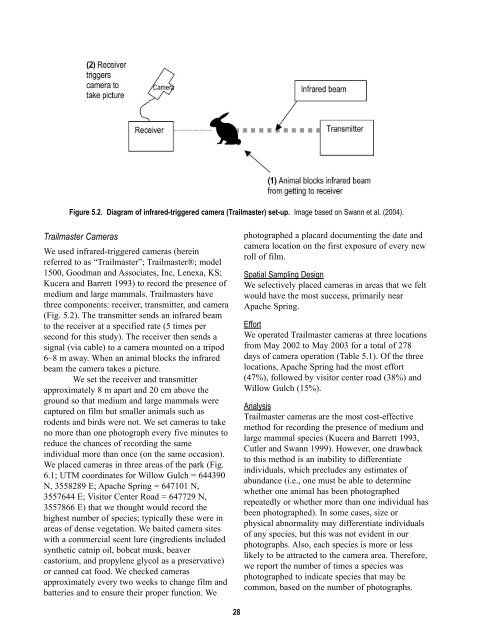Download this report as a 94-page PDF - USGS
Download this report as a 94-page PDF - USGS
Download this report as a 94-page PDF - USGS
Create successful ePaper yourself
Turn your PDF publications into a flip-book with our unique Google optimized e-Paper software.
Figure 5.2. Diagram of infrared-triggered camera (Trailm<strong>as</strong>ter) set-up. Image b<strong>as</strong>ed on Swann et al. (2004).<br />
Trailm<strong>as</strong>ter Camer<strong>as</strong><br />
We used infrared-triggered camer<strong>as</strong> (herein<br />
referred to <strong>as</strong> “Trailm<strong>as</strong>ter”; Trailm<strong>as</strong>ter®; model<br />
1500, Goodman and Associates, Inc, Lenexa, KS;<br />
Kucera and Barrett 1993) to record the presence of<br />
medium and large mammals. Trailm<strong>as</strong>ters have<br />
three components: receiver, transmitter, and camera<br />
(Fig. 5.2). The transmitter sends an infrared beam<br />
to the receiver at a specified rate (5 times per<br />
second for <strong>this</strong> study). The receiver then sends a<br />
signal (via cable) to a camera mounted on a tripod<br />
6–8 m away. When an animal blocks the infrared<br />
beam the camera takes a picture.<br />
We set the receiver and transmitter<br />
approximately 8 m apart and 20 cm above the<br />
ground so that medium and large mammals were<br />
captured on film but smaller animals such <strong>as</strong><br />
rodents and birds were not. We set camer<strong>as</strong> to take<br />
no more than one photograph every five minutes to<br />
reduce the chances of recording the same<br />
individual more than once (on the same occ<strong>as</strong>ion).<br />
We placed camer<strong>as</strong> in three are<strong>as</strong> of the park (Fig.<br />
6.1; UTM coordinates for Willow Gulch = 644390<br />
N, 3558289 E; Apache Spring = 647101 N,<br />
3557644 E; Visitor Center Road = 647729 N,<br />
3557866 E) that we thought would record the<br />
highest number of species; typically these were in<br />
are<strong>as</strong> of dense vegetation. We baited camera sites<br />
with a commercial scent lure (ingredients included<br />
synthetic catnip oil, bobcat musk, beaver<br />
c<strong>as</strong>torium, and propylene glycol <strong>as</strong> a preservative)<br />
or canned cat food. We checked camer<strong>as</strong><br />
approximately every two weeks to change film and<br />
batteries and to ensure their proper function. We<br />
28<br />
photographed a placard documenting the date and<br />
camera location on the first exposure of every new<br />
roll of film.<br />
Spatial Sampling Design<br />
We selectively placed camer<strong>as</strong> in are<strong>as</strong> that we felt<br />
would have the most success, primarily near<br />
Apache Spring.<br />
Effort<br />
We operated Trailm<strong>as</strong>ter camer<strong>as</strong> at three locations<br />
from May 2002 to May 2003 for a total of 278<br />
days of camera operation (Table 5.1). Of the three<br />
locations, Apache Spring had the most effort<br />
(47%), followed by visitor center road (38%) and<br />
Willow Gulch (15%).<br />
Analysis<br />
Trailm<strong>as</strong>ter camer<strong>as</strong> are the most cost-effective<br />
method for recording the presence of medium and<br />
large mammal species (Kucera and Barrett 1993,<br />
Cutler and Swann 1999). However, one drawback<br />
to <strong>this</strong> method is an inability to differentiate<br />
individuals, which precludes any estimates of<br />
abundance (i.e., one must be able to determine<br />
whether one animal h<strong>as</strong> been photographed<br />
repeatedly or whether more than one individual h<strong>as</strong><br />
been photographed). In some c<strong>as</strong>es, size or<br />
physical abnormality may differentiate individuals<br />
of any species, but <strong>this</strong> w<strong>as</strong> not evident in our<br />
photographs. Also, each species is more or less<br />
likely to be attracted to the camera area. Therefore,<br />
we <strong>report</strong> the number of times a species w<strong>as</strong><br />
photographed to indicate species that may be<br />
common, b<strong>as</strong>ed on the number of photographs.

















